Epidote (silicates): Axinite
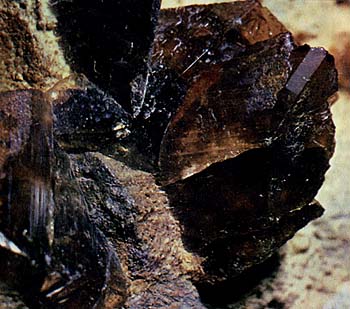 Diagnostic Card.
Diagnostic Card.
On the picture. Triclinic crystals axinite from Bourg-d'Uasan (department of Isère, France).
Ca 2 (Fe, Mn) Al 2 BO 3 OH Si 4 O 12
Crystal system triclinic
Hardness of 6.5-7
Specific weight 3,25-3,3
Cleavage is perfect
fracture conchoidal
Color from yellow to brown
Color white powder
Gloss glass
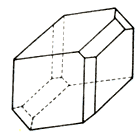
Axinite - is the name of the group, three members of which contain, respectively, iron, magnesium and manganese - ferroaksinit, magnezioaksinit, manganaksinit and tintsenit (Ca-Mn-Fe). Crystals accrued fragmented or connected as a friend, with very sharp edges, wedge-shaped, rich in faces; as well as solid, shelly, lamellar (layered up) units. Cleavage is clear; a density of 3.3; color brown, gray, purple, plum, blue, green, rarely red. Very noticeable pleochroism.
The name is derived from the Greek AXE - Axe for acute wedge-shaped head of the crystal. It has a strong glass luster; characteristic piezoelectric properties. Formed in skarns. It is found in France (Dep. Of Isère), Mexico (Baja California), USA (Calif.). Axinite be confused with smoky quartz.
Chemical composition - unstable, especially on the content of manganese; Magnesium impurity observed, sometimes potassium and sodium. Crystals - usually plate or lanceolate, with sharp edges and shading on the edges. Root simple shapes (010), (120), (110), (121), (011), (111) Pinakoidalny kind of symmetry. Cleavage - perfect for (010).
axinite crystals belong to the triclinic system. They have flattened and beveled shape, apex pointed, often verge isshtrihovany. In addition to well-formed individuals, translucent, sometimes transparent, with a glassy luster, axinite can form massive accumulations of dense lamellar structure and weight. The crystals have an average hardness fragile break with incorrect, cleavage in one direction. Pleochroism-volatile preobladayutottenki purple, brown and light green, but the difference between the observed manganaksinit blue, purple and grays.
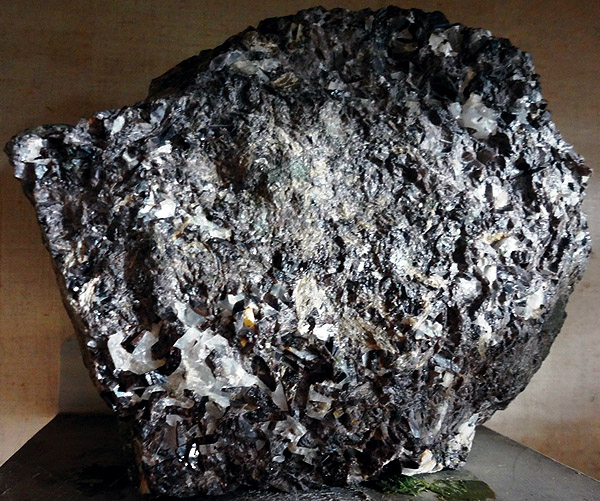
Axinite. M Canyon-set, Seimchan p., Magadan Region., Russia, CIS. Photo: © AA Evseev.
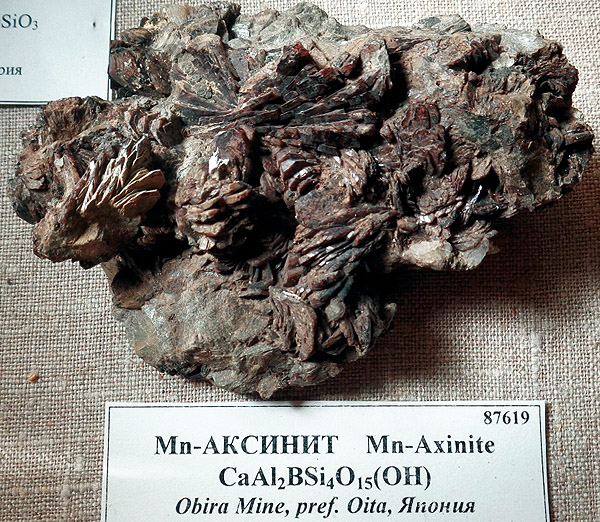
Mn-axinite. Robbing district to, Oita Prefecture. Japan. Photo: © AA Evseev.
Diagnostic features.
Axinite has weak pyroelectric properties. Acids can not be, legkoplavok.
Origin.
It is formed during the metamorphism in the contact aureoles in calcareous or basic igneous rocks, riddled bodies of granite type, enriched boron. Pneumatolytic origin, similar to tourmaline, due to the rocks, rich in limestone. Less common, but with the formation of a very beautiful crystals, hydrothermal origin of granites in the voids and along the periphery of the intrusions.
Place of Birth.
Famous deposits axinite now partially developed, located near Bourg-d'Uasan (department of Isère, France), in Koarz Gold (CA), Cornwall (United Kingdom) and Grizhioni (Switzerland). Small deposits were found in Brazil, Germany and Tanzania. In Italy, it noted several locations of interest to collectors. Among them, the Valle del Cervo (Biella), Monzoni group Valdi Fassa (province of Trento), the island of La Maddalena (Province of Sassari, Sardinia) and Baveno (Province of Verbania). Key findings: Saxony (Germany), Isere (France), Cornwall (England), Tintsen (Switzerland, hence the name tintsenita), Liguria, Sardinia (Italy); large purple crystal gemstone quality are in Lunige (Nevada, USA).
The use in jewelry.
This gem is usually no more than five carats, treated with square facets in the step and in the rotunda; numerous facets in the pavilion. Massive limits the difference in cabochon. The name comes from the Greek. "Ax", due to the wedge shape and the tapered edges of the crystals. It makes sense only for collectors and as a rare gem.
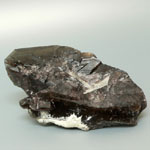
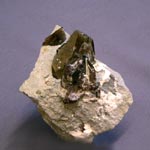
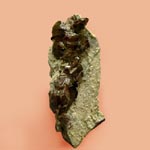

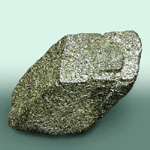

Axinite. Chegitun, Russia. Photo: © AA Evseev.
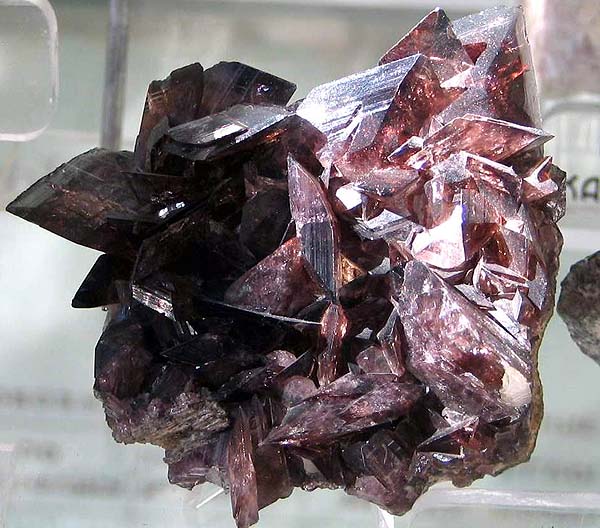
Axinite (ferroaksinit). Bur d`Uazan, Isère, France. Photo: © AA Evseev.
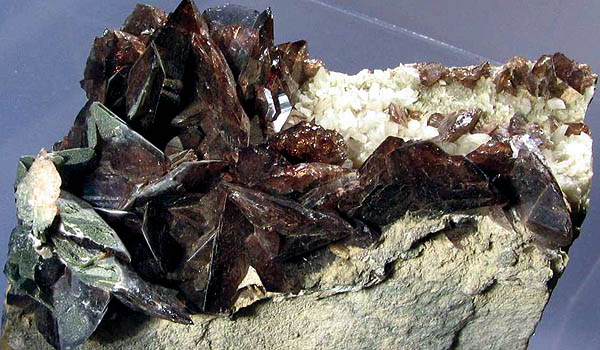
Axinite. Ferroaksinit. Man-Hobeyu solder. Ural, Russia. Photo: © AA Evseev.
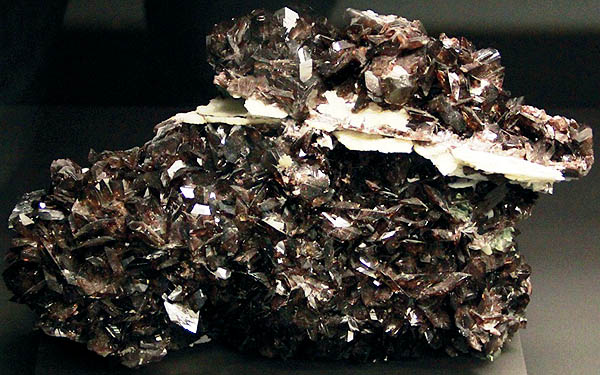
Axinite. Ferroaksinit. Puyva solder. Ural, Russia. Photo: © D. Tonkacheev.
- Gatchell - "New Almadén snag" - arsenide and antimony sulfide (modern sulphosalts)
- Antimony - toxic metal (semi-metal) are widely used in industry, medicine and engineering
- Zirconium - a rare and non- metal and dangerous jewel in the oxide and salts
- Gold - yellow dangerous and toxic metal -date and accurate digital cable technology
- Sulphur - a golden-yellow toxic substance and a sign of volcanic activity
- Cadmium - a toxic uncirculated unknown wide range of people silvery metal
- Lead - a poisonous gray simulator silver metal and toxic metal snag
- Arsenic - poison classic medieval and modern poisoners and medicine in medicine
Toxic and hazardous radioactive rocks and minerals
** - Poisonous stones and minerals (obligatory check in chemical laboratory + clear indication of toxicity)
** - Radioactive rocks and minerals (obligatory check on OEM + dosimeter ban on open sale in the case of radioactivity more than 24 mR / hour + additional measures to protect the population)
Catalog minerals and gems in groups of the world
** - Poisonous stones and minerals
** - Radioactive rocks and minerals


Comments
Commenting, keep in mind that the content and the tone of your messages can hurt the feelings of real people, show respect and tolerance to his interlocutors, even if you do not share their opinion, your behavior in terms of freedom of speech and anonymity offered by the Internet, is changing not only virtual, but real world. All comments are hidden from the index, spam control.